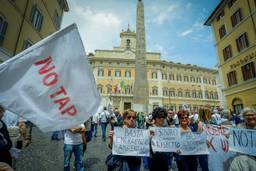Despite everything, California’s recall race is moving at full speed.
Despite Gov. Gray Davis’ appeal to Democrats not to run against him. Despite his assertion that the recall is a Florida-style conspiracy by Republicans to “steal elections [they] can’t win.” Even despite attempts to push back voting day. A federal court ruled against the ACLU’s request to postpone the election until March, when six counties, including Los Angeles and San Diego, will have finally upgraded from the faulty punch-card voting system.
But whoever wins the October 7th election will also inherit a $38.2 billion deficit and the worst credit rating of any state in the nation.
How did California get here? Many blame the current crisis on the collapse of the technology boom, the energy crisis, and national economic downturn. But that’s only part of the picture.
Davis’ own misguided spending and policy priorities are as big a reason as any for California’s current troubles. A brief look at Davis’ budget, signed in early August, shows how he has sold California’s future down the river.
Davis has slashed just about every state-funded program, including education, health care, and workforce development. But one institution seems to be immune from the epidemic belt-tightening: prisons. With just a one percent overall reduction, the Department of Corrections’ budget remains almost completely intact.
Some areas of the prison budget even get a big boost—mostly luxuries for the department bureaucracy and for prison employees. Davis makes up the difference by gutting health care, educational and vocational programs, drug rehabilitation, and other services for inmates.
Why would prisons escape Davis’ ruthless budget axe? Just follow the paper trail.
Davis has accepted $3.4 million in campaign contributions from the California Correctional Peace Officers Association (CCPOA)—the state’s prison guards’ union—for his two gubernatorial campaigns in ’98 and ’02. The union gave Davis the largest single check he has ever received from a group—$251,000. And Davis is repaying them many times over.
Despite pay hikes in 1998, 1999, and 2000, Davis has approved raising the average prison guard salary even more— to a whopping $73,428 by 2006. That will cost taxpayers an extra $120 million this year. By 2006, the annual price tag will be about $700 million.
And because Davis is paying for this raise by mortgaging California’s future, the long-term costs are even greater. Between cutting programs he should bolster and ignoring others that could save millions, Davis is burning California’s bridges to a safe, deficit-free tomorrow.
To finance this unnecessary and exorbitant prison guard pay raise, Davis is cutting prison literacy and vocational programs. These are some of the only programs proven to reduce recidivism. Cutting them means more crime — and more taxpayer dollars spent locking up repeat offenders.
Davis could save money and make California safer by investing in alternatives to incarceration. Alternatives like job training and placement, drug treatment and mental health, and social service programs have been proven to reduce crime and reduce cost. These alternatives are cheaper and safer for everybody: the state, the community, and the offender.
But Davis isn’t interested in keeping California safe or out of the red. He only cares about pandering to special interests like the prison guards’ union.
That’s why prison guards are getting pay raises while teachers across the state are getting pink slips. That’s why youth programs are closing their doors and violence prevention programs are shutting down shop. That’s why parks and recreation, daycare centers, and public health programs are all hemorrhaging. That’s why California is in crisis and turmoil. Disaster is hard to avoid with a governor who will sell out the state for a few million dollars in campaign contributions.
California politics are more than just a sensational news story, a drama worthy of daytime television. As the nation turns its eyes toward the Golden State, it should see not only headlines and lead stories, but a cautionary tale.
Incarceration is one of the biggest and fastest growing industries of the 21st century. Prison lobbies, like the CCPOA, have become extremely powerful. The CCPOA alone has spent at least $9.6 million since 1998 putting politicians like Gray Davis in its pocket. Similar lobbies are active at every level of government, across the country.
As the national economy continues to struggle, every state will be looking to make significant and difficult cuts. If California teaches us anything, it is that, before states cut valuable programs, they should cut their strings to the prison lobbies. Otherwise, they may follow California’s disastrous lead into crisis and turmoil.
Despite Gov. Gray Davis’ appeal to Democrats not to run against him. Despite his assertion that the recall is a Florida-style conspiracy by Republicans to “steal elections [they] can’t win.” Even despite attempts to push back voting day. A federal court ruled against the ACLU’s request to postpone the election until March, when six counties, including Los Angeles and San Diego, will have finally upgraded from the faulty punch-card voting system.
But whoever wins the October 7th election will also inherit a $38.2 billion deficit and the worst credit rating of any state in the nation.
How did California get here? Many blame the current crisis on the collapse of the technology boom, the energy crisis, and national economic downturn. But that’s only part of the picture.
Davis’ own misguided spending and policy priorities are as big a reason as any for California’s current troubles. A brief look at Davis’ budget, signed in early August, shows how he has sold California’s future down the river.
Davis has slashed just about every state-funded program, including education, health care, and workforce development. But one institution seems to be immune from the epidemic belt-tightening: prisons. With just a one percent overall reduction, the Department of Corrections’ budget remains almost completely intact.
Some areas of the prison budget even get a big boost—mostly luxuries for the department bureaucracy and for prison employees. Davis makes up the difference by gutting health care, educational and vocational programs, drug rehabilitation, and other services for inmates.
Why would prisons escape Davis’ ruthless budget axe? Just follow the paper trail.
Davis has accepted $3.4 million in campaign contributions from the California Correctional Peace Officers Association (CCPOA)—the state’s prison guards’ union—for his two gubernatorial campaigns in ’98 and ’02. The union gave Davis the largest single check he has ever received from a group—$251,000. And Davis is repaying them many times over.
Despite pay hikes in 1998, 1999, and 2000, Davis has approved raising the average prison guard salary even more— to a whopping $73,428 by 2006. That will cost taxpayers an extra $120 million this year. By 2006, the annual price tag will be about $700 million.
And because Davis is paying for this raise by mortgaging California’s future, the long-term costs are even greater. Between cutting programs he should bolster and ignoring others that could save millions, Davis is burning California’s bridges to a safe, deficit-free tomorrow.
To finance this unnecessary and exorbitant prison guard pay raise, Davis is cutting prison literacy and vocational programs. These are some of the only programs proven to reduce recidivism. Cutting them means more crime — and more taxpayer dollars spent locking up repeat offenders.
Davis could save money and make California safer by investing in alternatives to incarceration. Alternatives like job training and placement, drug treatment and mental health, and social service programs have been proven to reduce crime and reduce cost. These alternatives are cheaper and safer for everybody: the state, the community, and the offender.
But Davis isn’t interested in keeping California safe or out of the red. He only cares about pandering to special interests like the prison guards’ union.
That’s why prison guards are getting pay raises while teachers across the state are getting pink slips. That’s why youth programs are closing their doors and violence prevention programs are shutting down shop. That’s why parks and recreation, daycare centers, and public health programs are all hemorrhaging. That’s why California is in crisis and turmoil. Disaster is hard to avoid with a governor who will sell out the state for a few million dollars in campaign contributions.
California politics are more than just a sensational news story, a drama worthy of daytime television. As the nation turns its eyes toward the Golden State, it should see not only headlines and lead stories, but a cautionary tale.
Incarceration is one of the biggest and fastest growing industries of the 21st century. Prison lobbies, like the CCPOA, have become extremely powerful. The CCPOA alone has spent at least $9.6 million since 1998 putting politicians like Gray Davis in its pocket. Similar lobbies are active at every level of government, across the country.
As the national economy continues to struggle, every state will be looking to make significant and difficult cuts. If California teaches us anything, it is that, before states cut valuable programs, they should cut their strings to the prison lobbies. Otherwise, they may follow California’s disastrous lead into crisis and turmoil.
Attorney Van Jones is founder and director of the Ella Baker Center for Human Rights. He is presently on unpaid leave, working as the Grassroots Director for the Arianna Huffington for Governor campaign. He has played a key role in developing the campaign’s “Schools Not Jails” platform.






